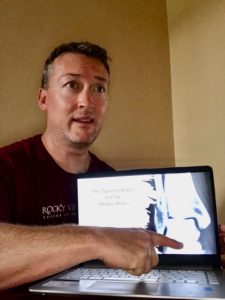Ms. Peggy, the founder here at Clinica Esperanza, is very adamant that everyone learns from one another. That means she expects both volunteers, like me, and long term staff to both teach and to learn. This happens formally every day from 11:45-noon like clock work. 1 person or group is assigned every day to teach a simple 10-15 minute lesson on any topic of interest. Peggy’s commitment to teaching and learning could be seen during the time of COVID when there were no volunteers at the clinic and the staff had to man the teaching role continuously. Despite a few requests to put it on hold until the volunteers came back, Peggy pushed on and kept it going! Topics range from tropical diseases like Dengue, Malaria, or Chagas disease, to practical matters like wound irrigation or deciding when an xray is necessary and when it is not (that was mine!).
But teaching and learning goes far beyond the formal 15 min daily assignment.  Staff and volunteers ask each other for help or clarification on any variety of issue or topic! This atmosphere of collaboration and humble cooperation, I think, is due to Peggy’s continual focus on teaching and learning. As a volunteer here, I have the opportunity to learn a lot from the local doctors, pharmacists and staff. I have learned a lot about the process of running a clinic, how they order and organize medications and office supplies, working collaboratively with the community, local dosing differences and so much more. I have also had the opportunity to teach some skills I have that some of the other volunteers or staff physicians are not as comfortable with: suturing, nail removal, casting, etc. For instance, one of the local docs here was very comfortable making plaster casts, but the clinic only had casting tape – a whole different animal. He had done his best and made a cast that had worked very well for about 3 weeks, but was getting uncomfortable for the patient and he did not really like the end result as well as other casts he had done with plaster. I was able to help him and another doc there learn how to remove the cast easily with a cast saw and then I showed them how to put on the cast with cast tape (including proper padding). I put down the first layer, and then he put on the second layer. When all was said and done, the cast turned out great and the local doc felt much more comfortable using the casting tape that the clinic had in supply on future patients.
Staff and volunteers ask each other for help or clarification on any variety of issue or topic! This atmosphere of collaboration and humble cooperation, I think, is due to Peggy’s continual focus on teaching and learning. As a volunteer here, I have the opportunity to learn a lot from the local doctors, pharmacists and staff. I have learned a lot about the process of running a clinic, how they order and organize medications and office supplies, working collaboratively with the community, local dosing differences and so much more. I have also had the opportunity to teach some skills I have that some of the other volunteers or staff physicians are not as comfortable with: suturing, nail removal, casting, etc. For instance, one of the local docs here was very comfortable making plaster casts, but the clinic only had casting tape – a whole different animal. He had done his best and made a cast that had worked very well for about 3 weeks, but was getting uncomfortable for the patient and he did not really like the end result as well as other casts he had done with plaster. I was able to help him and another doc there learn how to remove the cast easily with a cast saw and then I showed them how to put on the cast with cast tape (including proper padding). I put down the first layer, and then he put on the second layer. When all was said and done, the cast turned out great and the local doc felt much more comfortable using the casting tape that the clinic had in supply on future patients.
